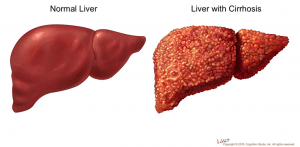Cirrhosis is a chronic (long-lasting) liver problem resulting from damaged and scarred liver tissue. Cirrhosis cannot be cured, but it can be treated.
A healthy liver metabolizes proteins, carbohydrates and fats, makes a digestive fluid (bile), removes blood toxins and is involved in blood clotting. With the scarring and damage of cirrhosis, the liver is unable to function properly. In some cases, cirrhosis can lead to liver failure, necessitating a liver transplant.
Common symptoms
- Fatigue, weakness and lack of appetite
- Vomiting with or without food
- Weight loss or weight gain
- Yellowish skin and eyes (jaundice)
- Itching
- Swollen abdomen and legs
- Intestinal bleeding
- Easy bruising of the skin
- Dilated veins in the esophagus and stomach
- Poor mental function
Causes of Cirrhosis
- Alcohol use
- Viral liver infections, such as hepatitis
- Chronic bile duct blockage
- Certain inherited diseases resulting in too much copper or iron stored in the liver
- Certain medications
- Nonalcoholic fatter liver disease
- Autoimmune disease
Treating Cirrhosis
Treatment, which can include medications and lifestyle changes, can control or slow liver scarring. That’s why prompt diagnosis and treatment, along with regular visits to your doctor and support of family and friends are essential. If the causes of cirrhosis are not treated, your liver problem may worsen over time and can lead to severe liver damage or failure.
Treatment plans may include:
- Medications to treat infection, bile duct blockage or problems with the brain and nervous system (hepatic encephalopathy). Medication may be used to improve blood clotting.
- A reduced-‐salt diet and water pills to reduce any swelling in the abdomen or legs
- A healthy diet and possible weight loss program
- Severe cases of cirrhosis may need special treatments
Avoid alcohol!
Alcohol use can destroy liver cells.
If you have problems quitting alcohol, get the support your need.

